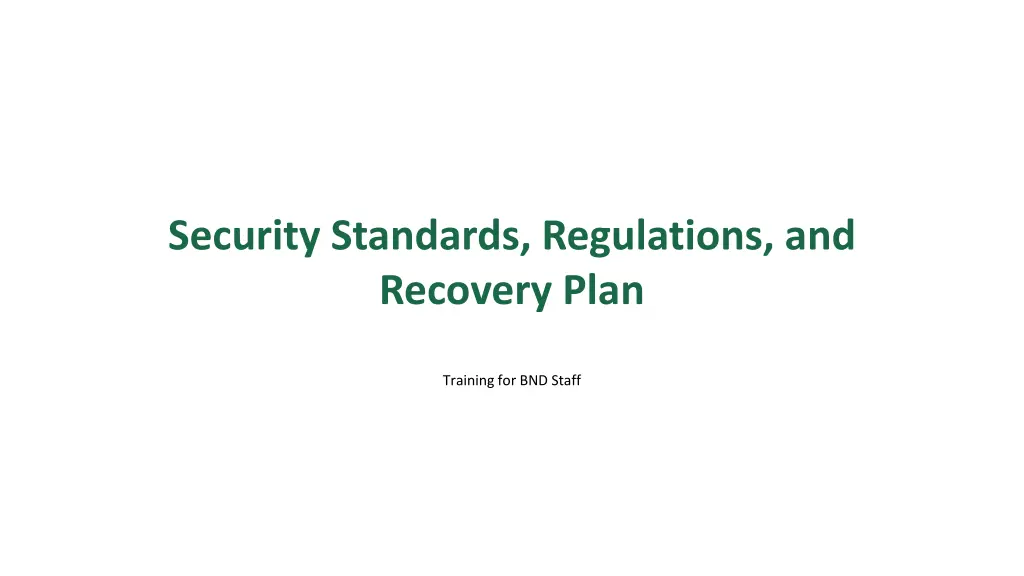
Understanding Security Standards, Regulations, and Recovery Plan Training
Delve into crucial security standards and regulations, navigate sector-specific regulations, and explore recovery plans in this comprehensive training for BND staff. Learn about ISO/IEC 27001, GDPR, NIST Cybersecurity Framework, PCI-DSS, HIPAA, FISMA, and more to enhance security awareness and compliance within your organization.
Download Presentation

Please find below an Image/Link to download the presentation.
The content on the website is provided AS IS for your information and personal use only. It may not be sold, licensed, or shared on other websites without obtaining consent from the author. If you encounter any issues during the download, it is possible that the publisher has removed the file from their server.
You are allowed to download the files provided on this website for personal or commercial use, subject to the condition that they are used lawfully. All files are the property of their respective owners.
The content on the website is provided AS IS for your information and personal use only. It may not be sold, licensed, or shared on other websites without obtaining consent from the author.
E N D
Presentation Transcript
Security Standards, Regulations, and Recovery Plan Training for BND Staff
01 Welcome to Your Security Journey Table of Contents 02 Training Objectives 03 Understanding Security Standards 04 Navigating Sector-Specific Regulations 05 Understanding Non-Compliance Consequences 06 Overview of the Recovery Plan 07 Justifying Our Security Decisions 08 Exploring Options and Alternatives 09 Key Takeaways 10 Questions and Discussion
1 Welcome to Your Security Journey Welcome everyone to this important training session! Today, we embark on a journey to understand the crucial landscape of security standardsand regulations. Through this session, we'll uncover the layers of protection designed to safeguard our organization against threats. Our main objectives include understanding security standards, consequences of non-compliance, and formulating a robust recovery plan. Let's equip ourselves with the knowledge to protect our digital assets effectively. Together, we'll create a secure environmentthat fosters trust and accountability.
2 Training Objectives This training aims to empower you with vital information regarding security standards and regulations. We will delve into various frameworks, focusing on their significance and applications within our workflows. Understanding consequences of non-compliance will highlight the importance of adhering to these standards. Lastly, we will discuss the recovery plan that ensures we can bounce back from any security incident. Let's strive for a culture of security awareness and compliance.
3 Understanding Security Standards We will explore key security standards includingISO/IEC 27001, GDPR, and NIST Cybersecurity Framework. ISO/IEC 27001 is an international standard for information security management systems, focusing on risk assessment and treatment. GDPR is all about data protection and privacy for individuals, ensuring businesses handle personal data responsibly. NIST Cybersecurity Framework provides guidelines to manage and reduce cybersecurity risk, enhancing security posture. These frameworks are essential for creating a structured approach to security.
4 Navigating Sector-Specific Regulations Various regulations guide industry-specific practices such as PCI-DSS, HIPAA, and FISMA. PCI-DSS focuses on securing credit card transactions, crucial for businesses handling payment data. HIPAA governs the protection of health information, ensuring privacy and security in healthcare systems. FISMA mandates information security for federal agencies, emphasizing risk management and compliance. Understanding these regulations helps us align with industry standards.
5 Understanding Non-Compliance Consequences Non-compliance can have dire repercussions for any organization. Financial penalties can be crippling,impacting budgets and profit margins significantly. Reputation damage can lead to loss of customer trust and loyalty, affecting long-term sustainability. Operational disruptions can hinderbusiness continuity, impacting productivity and service delivery. Legal consequences may arise, posing a threat to organizational integrityand stability.
6 Overview of the Recovery Plan In case of a security incident, our recovery plan lays out vital steps for effective incident response. Data backup and restoration strategies ensure critical information is recoverable and secure. Implementing security improvements post-incidentis vital for fortifying our defenses. Each component of the recovery plan plays a critical role in maintaining operational resilience. Preparedness is the key to a swift and effective recovery.
7 Justifying Our Security Decisions The selection of specific standards and frameworks is not arbitrary; it is well thoughtout. ISO/IEC 27001 aligns with our organizational goals for a structuredapproach to risk management. GDPR compliance is not just legal; it is a commitment to our clients privacy and data protection. NIST provides a flexible framework that adjusts to our evolving threatlandscape. These decisions are driven by the need for a robust security posture.
8 Exploring Options and Alternatives Let's explore the available tools and resources for strengthening our security framework. Various security tools offer protection against threats, enhancing our defenses. Backup solutions are essential for data integrityand recovery in case of incidents. Training programs deliver essential knowledge and skills to our personnel. The right choices here create a solid foundation for our security strategy.
9 Key Takeaways To wrap up, today s session highlightedcrucial aspects of security standards and regulations. Understanding compliance is vital for safeguardingour organizationagainst threats. Implementing a robust recovery plan is central to ensuring business continuity. We must remain vigilant and proactive in our approach to security. Let's uphold a culture of security awareness and compliance!
10 Questions and Discussion Now, we open the floor to your questions and discussions. Feel free to share your thoughts or seek clarification on any points covered today. Your insights are valuable to this learning experience. Let's engage in a fruitfuldiscussion to enhance our understanding. Thank you for your attentiveness and participation!
